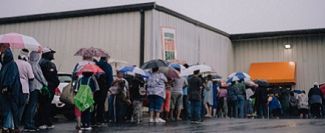Our Research
We believe that addressing the problem of hunger requires a thorough understanding of the problem. Released annually, our landmark study Map the Meal Gap looks at overall and child hunger down to the county level. New in 2022, it also includes estimates for select racial and ethnic groups.
As the coronavirus (COVID-19) crisis unfolds, we are using data to explore how food-insecure individuals and food insecurity rates may be affected.
The Hunger in America study was the largest and most comprehensive study providing insight into charitable food distribution in the United States.
We live in a dynamic world with data all around us. Data is one helpful tool to visualize the complex relationship between food insecurity and socioeconomic factors.
There are a variety of programs that exist to help those who lack access to enough nutritious food. In 2023, more than 50 million people received food assistance from the charitable food sector.
College students experiencing food insecurity may struggle to achieve their educational and professional goals.
There are individuals struggling to get by in every community across the country, but both poverty and food insecurity tend to be higher among residents of rural communities.
Insufficient financial resources create challenges and tradeoffs for households with incomes below the poverty line. These households experience food insecurity in addition to a range of financial insecurity and other hardships.
Existing research suggests that older individuals are at risk food insecurity. Seniors have fixed incomes, limited mobility, and changes in health that can render some older adults particularly vulnerable.
To better understand the disparities found in food insecurity caused by racism and structural oppression, Feeding America conducts research exploring the intersection of race & ethnicity and food insecurity.
Feeding America and the Urban Institute partner to explore the experiences, coping strategies, and viewpoints of teenagers dealing with food insecurity in 10 communities in the United States.
Hunger and Health
Many individuals experiencing food insecurity are forced to make a difficult choice between food and medical care in order to stretch the monthly budget. For people who have the additional burden of living with diabetes, these tradeoffs can be particularly harmful as one works to manage their disease.
Public policies and federal assistance programs such as SNAP work to support families with incomes below the poverty line.
In partnership with subject matter experts, practitioners, and academic associates, Feeding America conducts national evaluation studies on effective interventions to reduce food insecurity. Here we share robust data and evidence that informs the work done by network members and other key stakeholders.
The primary role of the Technical Advisory Group (TAG) is to review and provide ongoing feedback on Feeding America research projects in order to ensure our ability to deliver the highest quality of information to food banks and other service providers within the Feeding America network.















